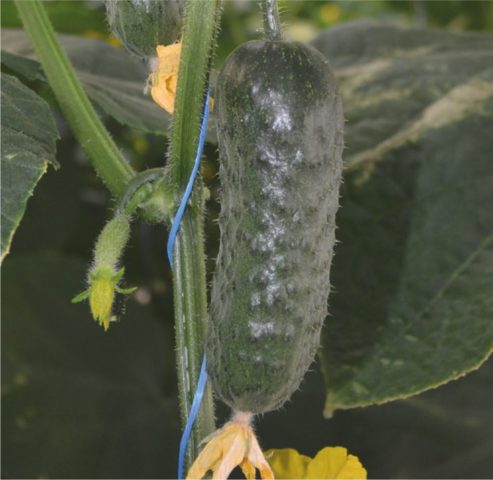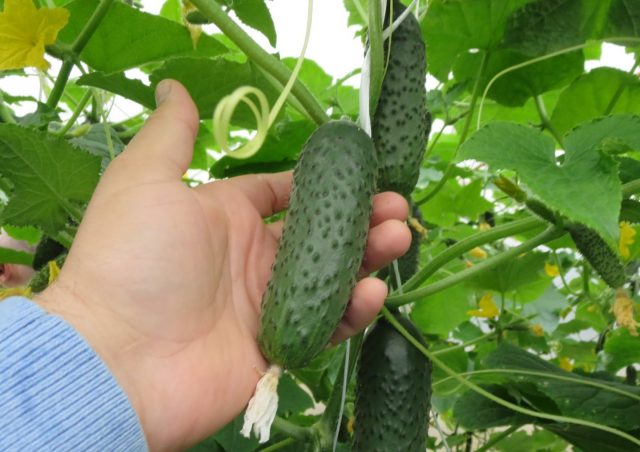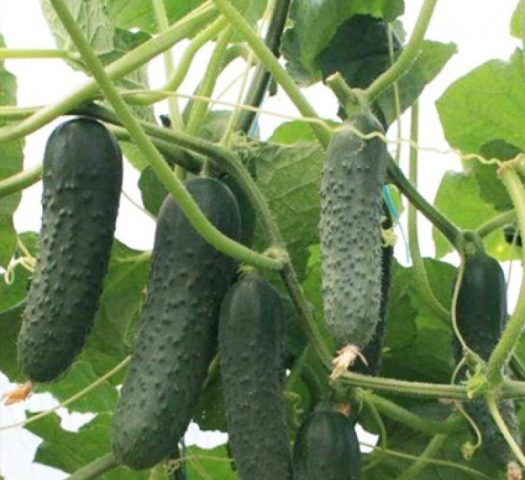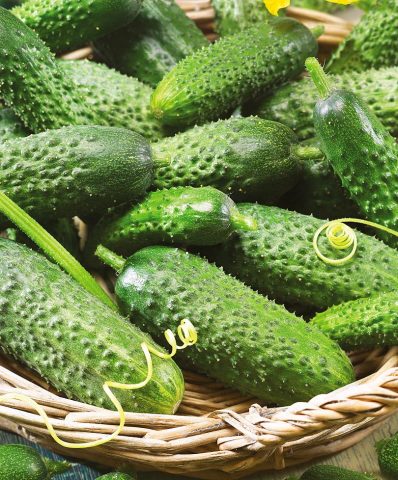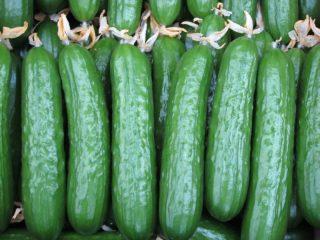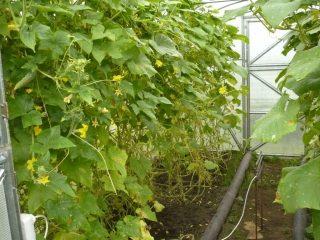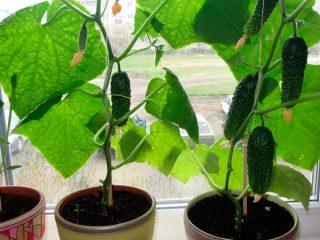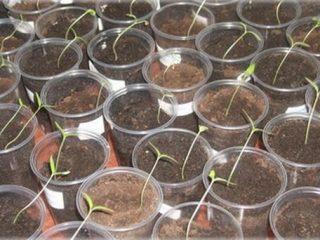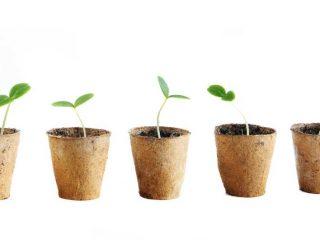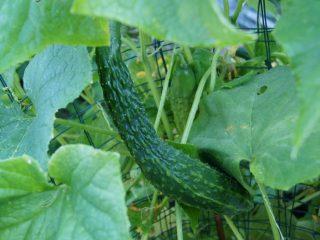Content
The Madrilene cucumber belongs to the new generation of hybrids. Selection work to create the species was carried out by the Dutch company Monsanto. The copyright holder of the variety is the Semenis concern of the USA; it is the main supplier of planting material on the world market. In Russia, the cultivation of the hybrid showed good results; they fully correspond to the characteristics declared by the originator.
Description of Madrilene cucumbers
The Madrilene variety was created for cultivation on protected ground in temperate climates; cultivation of the crop in open ground (OG) is possible at stable warm air temperatures. Cucumbers are of an indeterminate type and reach a height of three meters without growth restrictions. The bush is of a semi-standard type, produces few shoots; for better vegetation and fruit formation, side shoots are removed.
Cucumbers of the Madrilene variety are formed with one main stem, grown in a greenhouse and using the trellis method. The fruit filling rate is high; the stem cannot withstand the harvest without fixation. Height correction depends on the height of the support, on average it is 1.8 m.The ovaries should not be allowed to come into contact with the ground; without a garter, the greens turn yellow and fall off.
The Madrilene cucumber variety is parthenocarpic; the majority of the flowers are female, with a small number of male flowers; after a certain time they dry out and fall off. Females produce ovaries 100%. Abundant flowering provides the Madrilene variety with high productivity. The Madrilene cucumber is early ripening: 42 days pass from the appearance of young shoots to the ripening of the first fruits. Fruiting is long, the weight of cucumbers of the first wave and the last harvest is the same.
External description of the Madrilene cucumbers shown in the photo:
- A tall, open plant with short internodes. The main stem is medium thick, rough, flexible, light green in color. This variety of cucumber produces a small number of stepsons; the shoots are thin and poorly developed.
- The foliage is low, the leaves are dark green, small, heart-shaped, sparsely pubescent, the cuttings are short.
- The root of the variety is powerful, growing to the sides, the location is superficial, the central rod is poorly developed. The root system provides the plant with the necessary nutrients.
- The flowers are bright yellow, female predominate, the Madrilene cucumber variety is self-pollinating. Up to 3 ovaries are formed on one node.
Description of fruits
A feature of the Madrilene variety is the even shape of the fruits; from the first to the last ovaries they are of the same size and weight. Madrilene cucumber f1 is not prone to aging, overripe fruits retain juiciness, do not turn yellow, and there is no bitterness or acidity in the taste.
External characteristics of the fruit:
- have the shape of an elongated cylinder, reach no more than 10 cm in length, weight is 90 g;
- color – dark green, the surface has a pronounced bumpiness, each unevenness is lighter than the main tone, with short light fibers;
- the peel is thin, durable, glossy, no waxy coating, and withstands heat treatment well;
- the pulp is juicy, dense, without voids, the chambers contain a small amount of seeds;
- The taste of cucumbers of this variety is sweet, without acid or bitterness, with a pleasant aroma.
According to reviews from vegetable growers, Madrilene f1 cucumbers are stored for 4 days after harvest and tolerate transportation well.
The variety is grown in greenhouses on farms for industrial purposes. The multi-purpose fruits are consumed fresh; they are used as ingredients in assorted vegetables. The size of the vegetables allows them to be used for homemade preparations in their entirety. In salting and marinade they do not lose their elasticity and presentation.
Main characteristics of the variety
According to the description of the cucumber variety Madrilene f1, it is an early-ripening crop. The first wave of harvesting occurs in mid-June, fruiting lasts a long time, the last cucumbers are harvested before the onset of frost, in the OG approximately in the second half of September. Cucumbers are grown throughout the Russian Federation; fruiting in closed areas is higher than in open ground.
The Madrilene variety does not require excess sunlight. Cucumber photosynthesis and vegetation do not slow down in a periodically shaded area. In greenhouse structures, the plant does not need additional lighting. At an early stage of development, Madrilene cucumbers safely tolerate temperatures dropping to +8 0C. After planting in open ground, young shoots are not covered at night.
The variety's drought resistance is average; cucumbers can tolerate high temperatures only with regular watering. Drying out the root circle inhibits the growth of gherkins; bitterness may dominate the taste. Cultivation in greenhouse structures involves drip root irrigation. When air humidity is high, there is a risk of developing a fungal infection. Overmoistening of the soil leads to root rotting.
Productivity
The hallmark of the crop is a consistently high yield; the Madrilene f1 cucumber, according to the description of the copyright holder and reviews from gardeners, gives high yields regardless of weather conditions. The only negative that you should pay attention to when choosing a bed is that the variety does not tolerate drafts. When exposed to a cold northern wind, the growing season of cucumbers is defective and the yield decreases.
Cucumbers ripen 1.5 months after the appearance of young shoots. Depending on the growing method, the first cucumbers are harvested in early or mid-June. The plant is not spreading, 1 m2 plant 3 pieces. The average yield of cucumbers per bush is 15 kg (in a greenhouse), the variety yields up to 12 kg in a greenhouse. From 1 m2 remove about 40 kg.
Resistance to pests and diseases
According to the description, Madrilene cucumbers are genetically adapted to most of the diseases that affect the pumpkin family. If there is high humidity in greenhouses, a fungal infection – anthracnose – may develop. When the first signs appear, the bushes are treated with colloidal sulfur or the “Hom” product is used.On OG, diseases practically do not affect the plant, but the whitefly butterfly can parasitize. Prevent its reproduction with the drug “Commander”.
Pros and cons of the variety
The advantages of the variety are:
- consistently high yields;
- evened fruit shape;
- versatility in use;
- shade tolerance;
- resistance to low temperatures;
- good preservation after collection;
- pleasant taste;
- resistance to diseases and pests.
The disadvantages of Madrilene cucumbers include the degeneracy of the variety. If you collected the planting material yourself, you may not be able to harvest the crop for the 3rd year.
Growing rules
Cucumbers are propagated by seeds; it is possible to plant them directly in the ground. To speed up the ripening time, it is recommended to grow the crop using seedlings.
Sowing time
Seeds of Madrilene cucumbers for growing seedlings are planted in early April. Plant 2 seeds in small containers or glasses made of plastic or peat. The seedlings are not picked, the root system is weak and does not tolerate transplantation well.
The seedlings are placed in the greenhouse bed in early May. In the exhaust gas after warming up the earth not lower than 12 0 C, the timing is determined by the characteristics of the regional climate.
Planting seeds directly into the garden bed is possible after the air warms up above +8 at night 0 C (around mid-May). In the greenhouse, seeds are planted in mid-April.
Selecting a location and preparing beds
The bed for cucumbers is determined on neutral soils; the best soil composition is sandy loam; the variety can be planted on loam with the addition of organic matter or peat. Be sure to follow the conditions of crop rotation; cucumbers are not grown in the same area without adding mineral fertilizers for more than 3 years.
The bed on the exhaust gas should be protected from the effects of cold wind; it is better to choose an area behind the wall of the building on the south side. The site is prepared in the fall, before the onset of cold weather. The soil is dug up and compost is added. In the spring before planting, the soil is dug up again and saltpeter or superphosphate is added.
How to plant correctly
Method of planting seedlings of Madrilene cucumbers in a greenhouse or greenhouse:
- The planting hole is made 15 cm wide and 20 cm deep.
- Organic matter is placed at the bottom.
- The seedling along with the root ball is placed vertically in the center.
- Fill up to the lower leaves and water.
Scheme for planting cucumber seeds in the garden bed:
- Make a 3 cm indentation.
- Place two seeds in one hole. After the leaves form, the weak plant is removed.
- Seedlings and seeds are placed 3 plants per 1m2.
- The distance between the holes is 35 cm.
Aftercare for cucumbers
The Madrilene cucumber variety is grown in the usual way for the crop. There are no special agricultural technology recommendations for the plant. Care includes:
- moderate watering, preventing the soil from drying out and becoming waterlogged;
- three feedings: the first - with saltpeter, a week after planting the cucumbers; second - at the time of formation of the ovaries, complex mineral fertilizers are used; the last - organic, before harvesting the first harvest;
- loosening and weeding as the top layer of soil dries out and weeds grow.
Cucumbers are indeterminate, so they need to be tied to a support. Growth requires correction; the top is bent to the height of the trellis. The bush of the variety is formed with one stem, the lateral shoots are removed. Cut off yellowed and lower leaves.
Conclusion
The Madrilene cucumber is an early-ripening hybrid, genetically resistant to infection and parasitic insects. The variety is characterized by high productivity. Fruits with a high gastronomic rating, smooth shape, universal use. The crop is grown in greenhouses and in unprotected areas. After harvesting, cucumbers are stored for a long time and safely transported.
Reviews of Madrilena cucumbers
